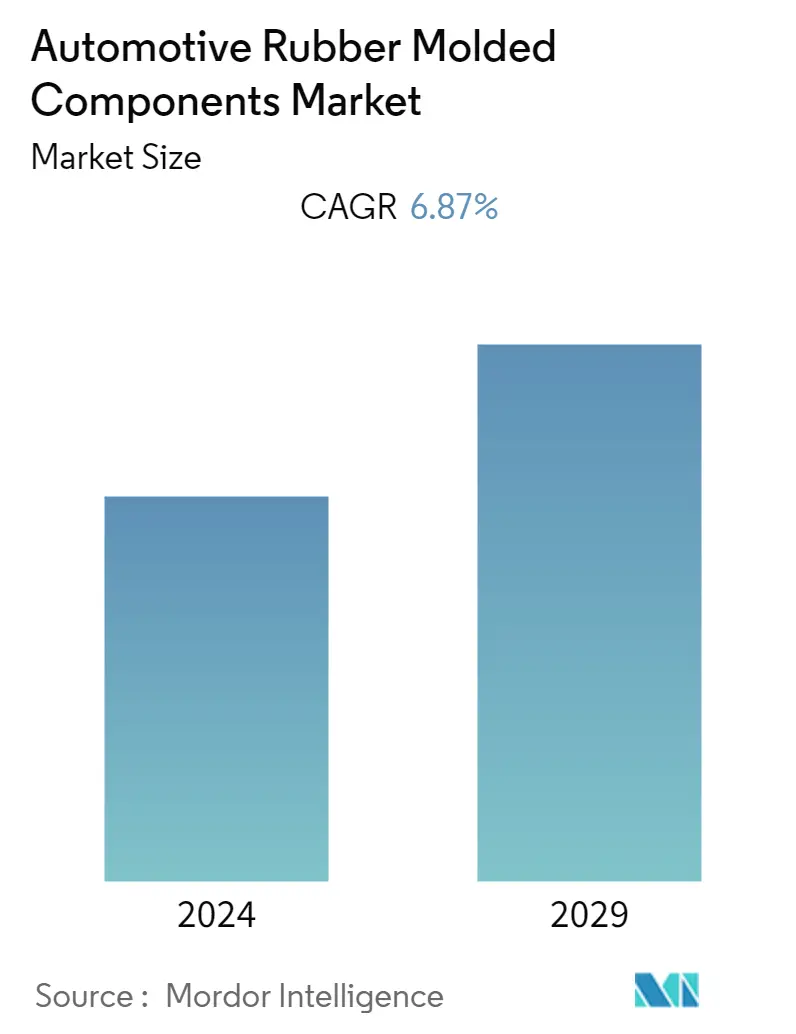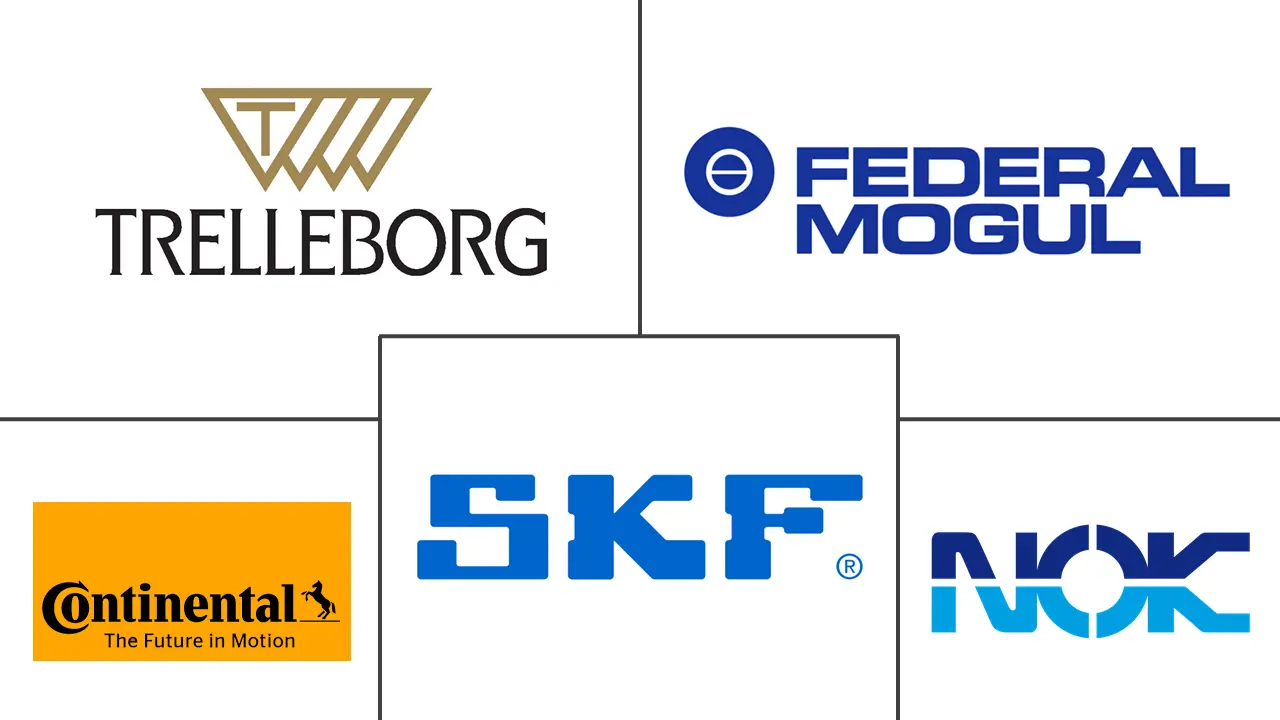Market Size of Automotive Rubber Molded Components Industry

| Study Period | 2019 - 2029 |
| Base Year For Estimation | 2023 |
| CAGR | 6.87 % |
| Fastest Growing Market | Asia Pacific |
| Largest Market | Asia Pacific |
| Market Concentration | Medium |
Major Players
*Disclaimer: Major Players sorted in no particular order |
Automotive Rubber-Molded Component Market Analysis
The automotive rubber-molded component market is anticipated to register a CAGR of about 6.87%, during the forecast period (2020 - 2025).
- The major players in the automobile industry are looking for various ways to reduce the overall weight of the vehicle. The reduced weight of the vehicle not only enhances the fuel efficiency of the vehicle but also reduces the pollutant emission from the exhaust and hence, complying with the stringent government norms and attract more demand. To meet the specific demand from OEMs, the sealing system manufacturers are benchmarking the present technology and the material used to make the new sealing systems, which is aimed to be lighter in weight, highly reliable, safe, and will possess lower production costs than conventional sealants.
- Advances in release agents, nowadays, are making rubber and its components more attractive to auto manufacturers. For hundreds of years, rubber has been used in the automotive industry. Rubber-molded products, which were formerly extracted from natural materials, are now being made from inexpensive and common synthetic polymers, owing to many factors, including weight, environmental, expense, and longevity concerns. These rubber-molded components can be molded into all shapes, sizes, and colors, for different use in the automotive industry. This is a major growth factor for the market studied.
- By utilizing renewable soy oil as a swap for 25% of the petroleum oil utilized in rubber, Ford succeeded in doubling the material's stretchability and diminishing the carbon discharges from its crude materials. The new formula can be utilized in car parts, like seals, gaskets, hoses, radiators, and floor mats. According to the International Rubber Study Group, the automotive sector holds more than 50% of the global rubber consumption, which exceeded 22 million metric ton in 2008. Owing to its benefits and applications in various processes, the use of rubber in car parts is further expected to rise during the forecast period.
Automotive Rubber-Molded Component Industry Segmentation
The automotive rubber-molded component market covers the latest trends and technological development in the automotive rubber-molded component, demand of the material type, component type, vehicle type, geography and market share of major automotive rubber-molded component manufacturers across the world.
| By Material Type | |
| Ethylene Propylene Diene Monomer (EPDM) | |
| Natural Rubber (NR) | |
| Styrene-butadiene Rubber (SBR) | |
| Other Material Types |
| By Component Type | |
| Seals | |
| Gaskets | |
| Hoses | |
| Weather-strips | |
| Other Component Types |
| By Vehicle Type | |
| Passenger Car | |
| Commercial Vehicle |
| Geography | ||||||
| ||||||
| ||||||
| ||||||
|
Automotive Rubber Molded Components Market Size Summary
The automotive rubber-molded component market is poised for significant growth, driven by the industry's focus on reducing vehicle weight to enhance fuel efficiency and meet stringent emission regulations. This shift is encouraging manufacturers to innovate with lighter, more reliable, and cost-effective sealing systems. The use of synthetic polymers in rubber-molded products is becoming more prevalent due to their environmental and economic advantages. The incorporation of renewable materials, such as soy oil, is also contributing to the sustainability of rubber components. The demand for ethylene propylene diene monomer (EPDM) rubber is particularly strong, given its favorable properties for automotive applications, including weather and vibration resistance, and its role in reducing vehicle emissions. The rise of electric and new energy vehicles is further propelling the demand for these components, as they require lightweight materials to enhance performance and comply with environmental standards.
The market landscape is moderately fragmented, with key players like Continental AG, DANA Holding Corporation, and Trelleborg AB leading the charge. These companies are expanding their operations globally, with new manufacturing facilities being established to meet the growing demand, particularly in the Asia-Pacific region. The region's focus on electrification and stringent emission norms is expected to drive the market's growth. In China, the government's push towards new energy vehicles is reshaping the market dynamics, while Japan's commitment to electric and hybrid vehicles is influencing the demand for rubber-molded components. As the automotive industry continues to evolve, the market for these components is expected to expand, supported by technological advancements and strategic investments by major players.
Automotive Rubber Molded Components Market Size - Table of Contents
-
1. MARKET DYNAMICS
-
1.1 Market Drivers
-
1.2 Market Challenges
-
1.3 Industry Attractiveness - Porter's Five Forces Analysis
-
1.3.1 Bargaining Power of Suppliers
-
1.3.2 Bargaining Power of Buyers/Consumers
-
1.3.3 Threat of New Entrants
-
1.3.4 Intensity of Competitive Rivalry
-
1.3.5 Threat of Substitute Products
-
-
-
2. MARKET SEGMENTATION
-
2.1 By Material Type
-
2.1.1 Ethylene Propylene Diene Monomer (EPDM)
-
2.1.2 Natural Rubber (NR)
-
2.1.3 Styrene-butadiene Rubber (SBR)
-
2.1.4 Other Material Types
-
-
2.2 By Component Type
-
2.2.1 Seals
-
2.2.2 Gaskets
-
2.2.3 Hoses
-
2.2.4 Weather-strips
-
2.2.5 Other Component Types
-
-
2.3 By Vehicle Type
-
2.3.1 Passenger Car
-
2.3.2 Commercial Vehicle
-
-
2.4 Geography
-
2.4.1 North America
-
2.4.1.1 United States
-
2.4.1.2 Canada
-
2.4.1.3 Rest of North America
-
-
2.4.2 Europe
-
2.4.2.1 Germany
-
2.4.2.2 United Kingdom
-
2.4.2.3 France
-
2.4.2.4 Rest of Europe
-
-
2.4.3 Asia-Pacific
-
2.4.3.1 China
-
2.4.3.2 Japan
-
2.4.3.3 India
-
2.4.3.4 Rest of Asia-Pacific
-
-
2.4.4 Rest of the World
-
2.4.4.1 South America
-
2.4.4.2 Middle East & Africa
-
-
-
Automotive Rubber Molded Components Market Size FAQs
What is the current Automotive Rubber Molded Components Market size?
The Automotive Rubber Molded Components Market is projected to register a CAGR of 6.87% during the forecast period (2024-2029)
Who are the key players in Automotive Rubber Molded Components Market?
AB SKF, Continental AG, Federal-Mogul Corporation, NOK Corporation and Trelleborg AB are the major companies operating in the Automotive Rubber Molded Components Market.

